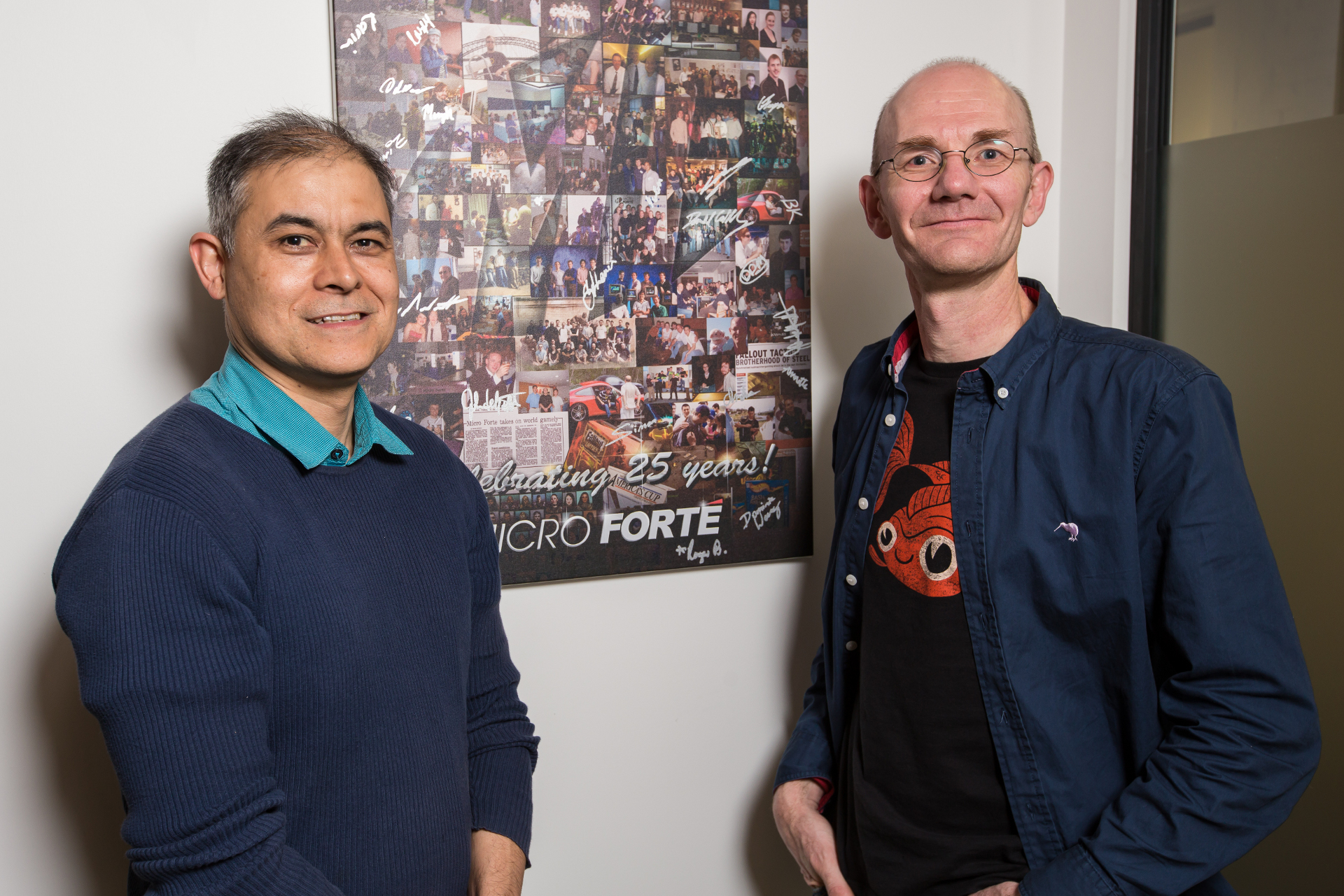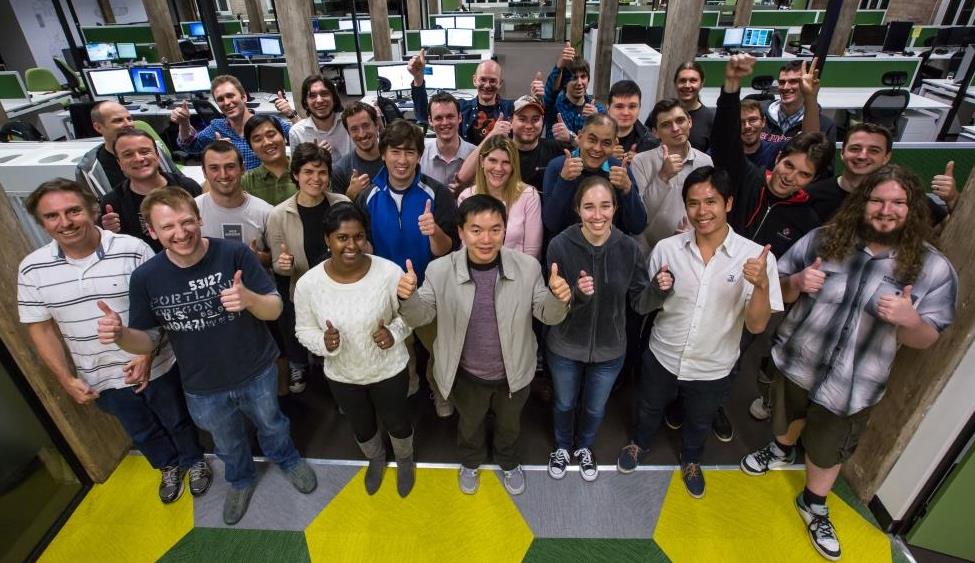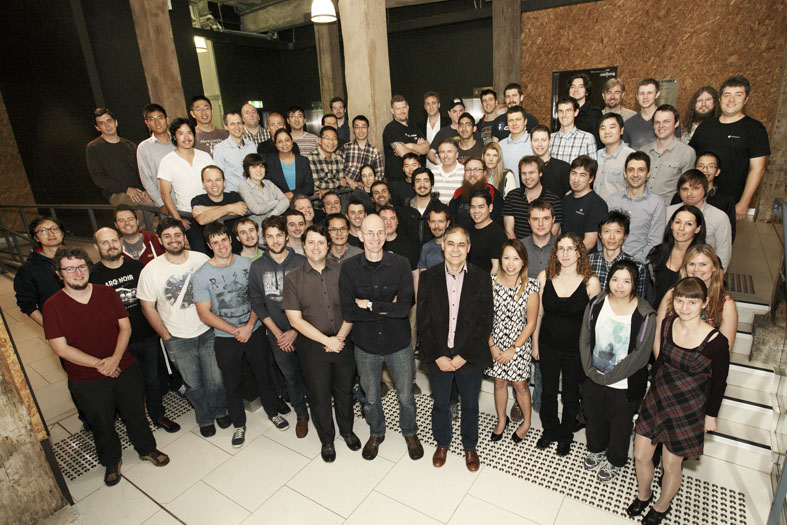Oh, what a BigWorld!

Peer behind the gamedev curtain in the merry old land of AUS.
Somewhere on the middle place between the CBD and the inner treads of suburbia, on a tributary that snakes away from Broadway, there is a particular office block, with nothing to distinguish it from its neighbours. A short stroll from Sydney’s Broadway Shopping Centre, it’s only from the inside that the premises begin to stand apart. For the most part the interior is atypical of any other IT company, but little touches on the walls and in the decor slowly align the place with the concocted motif of a gaming company.
“That’s one of the games from the 80s,” they say, pointing out a pair of five and a quarter discs framed on the wall. They in this case are Steve Wang, CEO of BigWorld Technology, and Simon Hayes, Chief Technology Officer. The two worked together in the 80s, on the Commodore 64 and PC respectively. “I can point out a couple of historical pictures where you can see that we actually had hair,” offers Wang.
“When people who aren’t involved in the industry ask what we do, we say our industry combines two of the most risky area; the forefront of technology, and entertainment, and makes a business out of it.” Their beginnings go back to the early days of MMOs like Ultima Online, and it’s in them that they saw a future, speculating that more would come.
BigWorld came from MicroForte, one of longer running Australian companies with a lifespan comparable to Strategic Studies Group (SSG), though yet started life proper as BigWorld at the tail end of the last millenium. Their best known games prior to their focus on technology were Enemy Infestation and Fallout Tactics, developed by colleagues in Canberra. Their first technology licence for BigWorld came in 2003, but it’s their adoption into the Wargaming family in 2011 that’s brought the biggest impact.
Beyond knowing more about Minsk than they ever thought likely, it’s their own exponential growth, mirroring that of Wargaming itself, that has seemingly changed them the most, and there is an almost giddiness in their voices as they reflect on the journey so far. BigWorld were a company of twenty-five before their involvement with Wargaming, and have since surpassed one-hundred people.

“One thing that’s changed for us is Wargaming’s transition from eighty people to thousands in a short time, partly through acquiring studios. They were already one of our customers, but when World of Tanks went so big, they acquired BigWorld so we could focus more on their titles.”
Wargaming is the developer and publisher of a series of freemium MMO games, those being World of Tanks, World of Warplanes, and the upcoming World of Warships. Each of the teams behind those games are located around the globe, and there’s acknowledgement of that within the BigWorld office. Alongside screens showing bug burn-down graphs on the next tech release, a set of live cam feeds serve as magic windows that bring the streets of Chicago, Minsk, Kiev, and Saint Petersberg a little closer.
Each of those cities holds a team responsible for a different slice of Wargaming, respectively World of Tanks, World of Tanks on Xbox, World of Warplanes and World of Warships. Sydney’s place in all this is not in gameplay or game design, but driving the core engine behind each game. It’s up to them to bring new features into the technology, improving performance and also keeping compatibility with older hardware. Half of their office is dedicated to the server team, while the other half of the floor (where BigWorld itself started) holds their testing team.
There’s a mix of computers across each of the workstations, covering a range of operating systems and IDEs – there’s no standard setup, and that’s by design. They recognise that what works for them is to employ smart people, and give them the flexibility to use the front end they want to – at least on the server/core engine side. The QA side of BigWorld is different, with the platform more standardised to variations of Windows, so they can run the necessary clients.
“We actually do a lot of testing. Because we work on the engine, we update the engine, improve it, make changes, merge our version in, and test it locally.” There’s a beckoning to gamers when they hear about testing role for a games company, envisaging hours spent playing their favourite games, well before anyone else gets a look-in, but Wang sets the record straight. “It’s kind of fun; when the QA guys needed to do a scaled test, we all jumped on to bash around with warships and blow each other up.”

So yes, it happens, but those are the exceptions. There’s also making it run on older machines, running stress tests and size tests with programmable bots, as well as the regular side of QA.
With BigWorld being involved with other Wargaming studios via both the engine and at the later stages of QA, their way of collaborating differs to what might normally happen with middleware providers. “We start with the core area of our expertise, anything in the engine, but they (the other studios) will also want to modify things based on their own gameplay and situation. The games are different enough to make considerable modifications to the technology base.”
Hayes adds to Wang’s comment. “There’s a regular visit every three months, but also an exchange of engineers, sending people over for up to a month at a time to help out.” Technology plays a big part of how they collaborate, with regular weekly skype calls, but also day-to-day connections between engineers to supplement the on-site visits. Another way in which the separate teams work together is through having representatives embedded inside each studio, giving a direct line of communication into the team – whether it’s in english or russian.
Both Wang and Hayes were frank about how game design is approached, and how the process is iterative not only in development, but in how the games are played. Each starts with the idea, a target that should be fun, but it’s not until they’re played that they know whether they met the mark. This means internal feedback and focus group testing, all to improve the qualities of play in parallel with the improvements to the client and engine. It’s not all shaders and framerates, but finding that approach that makes the player experience more upfront and personal – something that wasn’t the case in the early days of Warships.

The crunch that’s almost synonymous with stories about game development is raised, but it’s not as prevalent for BigWorld since their focus moved to middleware. The past is another matter, and the nature of game development is there’s crunch. Their targets now lean toward more regular releases, alleviating the pressure on any one release, and giving them the luxury to not be subject to it as they were before. They have the ability to continually improve, to release as needed, where a game’s release presents a kind of end; the best vision of the game, without much opportunity to make it better later. That’s not without its own critical points, but they differ to the need for an all-encompassing final release.
Their early days as middleware took place in a vacuum free of set release dates, instead focused on a specific feature set. Those release periods became longer than they wanted, but there were two reasons they shifted toward the more regular release cycle that they have now. The first was internal pressure; as a business that needed to push new versions of their technology, they needed more updates quicker, and to be less erratic in the schedule. The second was the purchase by Wargaming – they’d managed to hit their internal target for release just prior to the sale, and saw it as an incentive to keep the momentum going.
Hayes says they adhere to a form of agile methodology (with a side comment that anyone using agile also uses a form of agile). They work toward a major release each quarter, with that cycle broken into sprints, with different sprints on the server and client, and each team working with a team of project managers.
They acknowledge there is extra pressure in the week before release, but say that it’s nothing like the horror stories of teams spending months in crunch. Features do sometimes get bumped to a later release, but if there are features that a game team is waiting on, they prioritise those targets over optimisation or other pieces not critical to a game team. They’re less likely to defer a release for a set feature, due to the flow-on effect it would have to other teams, with other features then also being deferred. That’s one of the tricky parts that people often don’t recognise, says Wang. It’s also a two-way process, with the various game teams letting them know which features they need more, or earlier.
Their adoption into the Wargaming family has brought openness in how they handle issues with the middleware. In the early days of BigWorld, their product would be tested against their own parameters, but the relationship between them and their customers meant if there were problems, they were limited in what they could do. It was difficult for them to debug issues without access to source code, of which their customers were guarded about. “It sounds rough, but you’re basically developing something and throwing it over the fence for someone else to worry about,” explains Hayes.

That’s changed with Wargaming, bringing new possibilities to how they tackle issues. Steven Wang compares their path to other middleware providers, laying out the contrast between what was, and what is. “If you had a problem with Unreal as a developer, you would write code around it – not say Come on Mark Rein, send someone over to fix it. You wouldn’t even think it was part of the deal. But now it’s an option.”
Wargaming was the first European licensee for BigWorld Technology, with Chinese studios across Shanghai, Beijing and Shenzhen being a big export market for them earlier on. While there were others in the region that followed, Wang tells that Wargaming stood out from the beginning. “They’re a large organisation, but they’ve grown so quickly that their focus is on the problems, success and pushing forward. It’s been an interesting challenge dealing with a lot of clever, energised people – great people- but an engineer is an engineer, and you get them recognising the quality of each other’s work.”
The greatest insight into the culture of Wargaming is their annual conference; an internal gathering for developers where staff from Sydney, Chicago, Seattle, Kiev, Minsk and Saint Petersberg descend on a single place somewhere in the world. Last year it was Cyprus.
Hayes tells how he and Wang used to attend Game Developer conferences in America during the eighties, yet the Wargaming dev-con boasts greater numbers than those early few, but also represents something unique. “You can do the things you normally can’t. It’s always amazing, like a mini-GC, but because we’re the same company, there’s no restrictions on sharing ideas. You can’t do that at a normal conference.”
It’s perhaps Steve Wang’s words that best indicate where Wargaming is now, and where they (along with BigWorld) may head in the future.
“They’ve taken an inclusive approach to becoming a global organisation in such a short period of time. They recognise their operations are truly global. A bit like the United Nations, talks at the conference will be given in a language, either Russian or English, and like the United Nations, be simultaneously translated. It’s one of those things that shows their level of commitment to getting the most out of these things, and sharing the information so we make the best games we can.”
Wargaming (and BigWorld’s) World of Warships was released worldwide on on September 17. Thanks to PPR for organising the studio tour, Steve and Simon for being such great hosts, and special thanks to Jaqui at BigWorld for being instrumental in getting this article published.



